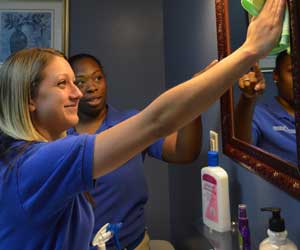83.3% of all house cleaners are either independent contractors or work for an individual. Your strongest weapon for claiming their market space is your quality control through integrated staff training.
I’m going to talk about training, but probably from a very different perspective: as a competitive advantage and a cost savings benefit. It’s not the usual discussion about training, but it’s a critical one if direct employment cleaning businesses are going to change the trends that seem to show a decline in the industry.
Only 16.6% of Cleaners are Direct Employees
A little more than 600,000 people in the US are cleaning homes as their primary source of income. Roughly one out of six (16.6%) are employees of cleaning companies; the rest are either self-employed or are employed by private households, according to data provided by Economic Modeling Specialists International (Figure 1). Furthermore, their data show that the number of self-employed house cleaners has risen 8.5% over the last six years, while the number of house cleaners who are employees has fallen 5.5%.

Over the next ten years both populations are expected to grow at about the same rate. The reasons for this should come as no surprise as they are all competing for the same customers, whether as an IC or a company sending out direct employees. The challenges each faces are similar: number of available direct employment jobs falling, minimum wage rising, entrance of new lower cost competition. And always we must account for changes in customer perception of a “deal” and of “value” as compared with the cleaning company’s or referral service’s idea of value; these perceptions are always in flux, and it is increasingly difficult to match them up.
Independent Contractor Businesses are Cheaper to Run
Being self-employed, often referred to as an independent contractor, has grown to mean a number of things in the house cleaning industry – from derogatory terms like illegal and trunkslammer to more sophisticated sounding titles like private housekeeper or personal assistant. Many house cleaners do work independently, finding their own jobs and handling the entire sales transaction directly with their clients. A segment of this independent contractor population comprises the “grey economy” in house cleaning where income is not reported, taxes are not paid, and insurance is not carried.
Independent contractors have a number of legal channels through which to find and provide services to consumers:
Domestic Referral Agency: a growing number of independent contractors are signing up with domestic referral agencies, which on the surface may look like traditional maid services but treat their cleaners as 1099 subcontractors.
Digital Marketplace: Companies like Care.com and Thumbtack.com are digital marketplaces where consumers find home service providers, and ultimately make the service agreement and financial transactions directly with the service provider. These may also be known as lead generation services.
Virtual Maid Service: Companies like Homejoy.com and Handy.com, companies we refer to as Virtual Mail Services (VMSs), go a step further and by being the merchant of record and subcontracting the work out to independent contractors.
In all of these cases there is a middle-man connecting the consumer to the independent contractor who is cleaning the home, and taking a part of the transaction for their trouble.
One reason the independent contractor model is taking off is that many business owners believe that the independent contractor model is a more cost effective way of offering service. For referral agencies and other intermediaries, arguably it is since the agency is typically not responsible for maintaining workers compensation insurance or payroll taxes, both of which comprise a large percentage of the labor costs of any service business. No wonder a growing number of companies are using an IC business model.
Direct Employee Business Models Pay Better
Another reason the independent contractor model is taking off is that many cleaning technicians and even consumers believe that the “private” technician is making more money than the “employed” technician. On the surface it may appear that ICs make an hourly rate that is higher than their employee counterparts, further contributing to the growth of the IC labor force. However, this rate often is applied only to the time in the home. When one accounts for the entire workday, transportation and supply costs, the true net hourly rate is more modest and can even fall below minimum wage. In fact, EMSI reports that employed house cleaners make more per hour than the self-employed, with higher wage earners making an average of 25% more per hour (Figure 2).

Conflicting Messages: Cleaning is an Unskilled Profession?
At first this statistic is counterintuitive. How can a cleaning company with employees and their associated costs afford to pay their best employees 25% more than their independent contractor competition? While there is not a single clear answer to this question, I would like to suggest that training is a significant contributing factor.
As every cleaning company struggles with empowering technicians to meet quality standards on a consistent basis, it may be surprising for you to learn that the US Bureau of Labor and Statistics identifies “cleaning” as a job that requires no training, and thus no skills: “No formal training or education is required. Most workers learn on the job.”
Further, in his recent announcement of funding to launch a new online referral service, SERVIZ founder Zorik Gordon said that “we are going after the skilled categories like plumbing and electrical, rather than the handymen and home cleaning services that a lot of our competitors focus on.” While it’s no secret that we’ve battled consumers to demonstrate to them that cleaning is science-based and skilled trade, now it seems we’ll also be competing with fellow home service providers for professional respect.
By contrast to the BLS, the US Department of Labor seems to acknowledge training and quality standards – and by extension professional skills – as a key factor in differentiating an employee versus an independent contractor. Training workers is considered a strong indicator that a worker is an employee rather than an IC. If the IRS determines that workers are misclassified as ICs, then the hiring company typically has to pay back taxes, interest and other penalties.
Cleaning companies with direct employees can train their employees. Since 83.3% of workers who are cleaning homes do not have this same opportunity, this represents a significant competitive advantage. If you are a business owner with employees, I would encourage you to continually expand and improve your training program to include at least three parts: initial training, ongoing training, and quality (or corrective) training. And I would encourage you to diversify your training beyond simply how to clean things in a home/office/site and to include a range of professional skills from work-appropriate behaviors to customer service and sales to basic, intermediate, and advanced skills leading toward promotion.
The Key Competitive Difference: Training and Quality Control
Building a successful house cleaning business is contingent upon a number of factors, not least of which is satisfied clients who consistently receive quality service. A professionally run cleaning company has the opportunity to establish a scope of work with its clients. Through training, this scope of work becomes the shared expectation between the client, the company, and the technicians providing the service. Training your cleaning technicians how to consistently meet your clients’ needs provides many benefits, including greater client retention, business growth, and employee retention and satisfaction.
Through training, companies can also reduce costs. The biggest opportunity here is to train technicians how to meeting client expectations in the least amount of time. Unlike companies using ICs, employers can provide their technicians with the most efficient equipment and supplies, and train them extensively on the proper methods and techniques to produce a quality outcome in the least amount of time possible. This is another huge competitive advantage of having employees because lower costs allow for a combination of more competitive pricing, higher profit margins, and higher wages – a triple win for all stakeholders.
Beyond Just Cleaning Training
Often overlooked is the value of safety training. Not having to pay workers compensation insurance is often identified as one of the competitive advantages held by companies that use ICs. While this may be true, the cleaning company with employees can neutralize this advantage with safety training – which can range from workplace safety, to personal security to defensive driving. A number of studies have concluded that companies that invest in workplace safety are more productive and profitable than those who don’t, and training can reduce the number of loses and keep insurance premiums to a minimum.
Customer service and sales training is an often overlooked opportunity for cleaning companies with employees. More than being great cleaners, employees need to be trained in professional communication, upselling, problem solving and more so that they are part of your customer satisfaction and retention program.
Your training program doesn’t have to be perfect. Often times the biggest improvements to performance come from increased commitment, not knowledge or skill. Training in these areas shows that it’s important and you care, and caring can be contagious.
The Bottom Line
The cumulative effect is that, through a significant commitment to comprehensive employee training, companies can
· Dramatically improve overall client satisfaction and reduce the potential for expensive losses due to theft, damage, and breakage
· Radically reduce both employee and client turnover, which in turn reduces your costs and increases your revenue and profits
· Deliberately creates a quality of employee with higher job satisfaction, greater personal dignity, and improved standard of living and draws applicants who exhibit similar qualities
Companies with employees have the true competitive advantage. If employers can exploit these opportunities, they can provide better service, better jobs, and run better companies, while capturing market share currently being serviced by the other 83.3% of house cleaners who have not been trained.
Tom Stewart and his wife, Janice Stewart, are co-owners of Castle-Keepers, the 1st company to achieve CIMS certification. Tom is a nationally-recognized leader & innovator in the house cleaning industry. He is co-founder and Publisher of Cleaning Business Today.





